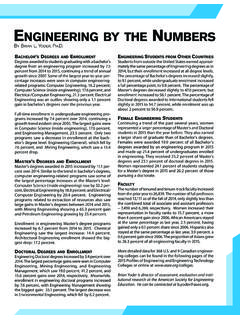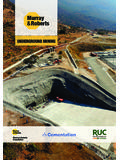Transcription of BY ORDER OF THE AIR FORCE INSTRUCTION 32-7044 …
1 BY ORDER OF THE SECRETARY OF THE AIR FORCE AIR FORCE INSTRUCTION 32-7044 18 AUGUST 2015 Incorporating Change 1, 22 April 2016 civil engineering STORAGE TANK ENVIRONMENTAL COMPLIANCE COMPLIANCE WITH THIS PUBLICATION IS MANDATORY ACCESSIBILITY: Publications and forms are available on the e-publishing website at for downloading or ordering. RELEASABILITY: There are no releasability restrictions on this publication. OPR: HQ USAF/A4CE Supersedes: AFI 32-7044 , 25 April 2012 Certified by: AF/A4CE (Mr. Kenneth Caligiuri) Pages: 51 Air FORCE INSTRUCTION (AFI) 32-7044 implements Air FORCE Policy Directive (AFPD) 32-70, Environmental Quality. It provides details of the Air FORCE Storage Tank Compliance Program. It identifies compliance requirements for storage tanks and associated piping storing petroleum and hazardous substances except hazardous waste. It explains how to assess, attain, and sustain compliance with applicable federal (40 CFR Parts 112 and 280), and applicable state and local environmental regulations, Final Governing Standards (FGS), or the Overseas Environmental Baseline Guidance Document (OEBGD), applicable international agreements, and related Department of Defense (DoD) and Air FORCE directives.
2 For DoD components at installations outside the United States, overseas, implement the applicable portions of this AFI in accordance with (IAW) international agreements and the applicable FGS or Environmental Governing Standards or, in their absence, the OEBGD. Any paragraph identified with an asterisk (*) does not apply to overseas installations. Unless otherwise noted, the guidance and procedures outlined in this INSTRUCTION apply to all Air FORCE installations within the United States. Additionally, this AFI applies to the Air FORCE Reserve, the Air National Guard, Government-Owned Contractor-Operated facilities, and Direct Reporting Units (DRU) and Field Operating Agencies (FOA) not located on Air FORCE installations. Further, the ANG or AFRC will support the intent of this Air FORCE INSTRUCTION , and where needed may prepare an appropriate policy, supplement, guidance, and/or procedural document reflecting its unique legal status, resources, and structure, as recognized by the reserve component authorities of Title 10 of the United States Code, Air FORCE Doctrine and other governing authorities.
3 The authorities to waive wing/unit level requirements in this publication are identified with a Tier ( T-0, T-1, T-2, or T-3 ) number following the compliance statement. See AFI 33-360, Publications and Forms Management, 2 AFI32-7044 18 AUGUST 2015 Table for a description of the authorities associated with the Tier numbers. Submit requests for waivers through the chain of command to the appropriate Tier waiver approval authority, or alternately, to the Publication OPR for non-tiered compliance items. Ensure all records created as a result of processes prescribed in this publication are maintained IAW Air FORCE Manual (AFMAN) 33-363, Management of Records, and disposed of in accordance with Air FORCE Records Disposition Schedule (RDS) in the Air FORCE Records Information Management System (AFRIMS). Send comments and suggested improvements on Air FORCE (AF) Form 847, Recommendation for Change of Publication, through channels, to Headquarters, United States Air FORCE , Energy and Environment Division (AF/A4CE), 1260 Air FORCE Pentagon, Washington, 20330-1260.
4 Any organization may supplement this INSTRUCTION . Major Commands (MAJCOM), FOA, and DRU send one copy of each supplement to AF/A4CE; other commands send one copy of each supplement to the next higher headquarters. See Attachment 1 for a glossary of references and supporting information. SUMMARY OF CHANGES This revision incorporates Interim Change (IC) 1. This IC (1) updates compliance statements and tier waiver authorities to ensure consistent tiering IAW AFI 33-360, Publications and Forms Management; (2) updates the office symbols of organizations; (3) retains previous revisions to include responsibilities to incorporate AF Program Action Directive (PAD) 12-03 Implementation of Enterprise-Wide civil Engineer Transformation; (4) continues to identify a standard database system for recording storage tank inventories; and (5) includes clarification of roles for programming for Defense Logistics Agency (DLA) environmental funds.
5 A margin bar (|) indicates newly revised material. Chapter 1 INTRODUCTION 4 Section 1A Overview 4 Concept.. 4 Scope.. 4 Objectives.. 4 Applicable Standards and Regulations.. 4 Section 1B Responsibilities 7 Secretary of the Air FORCE (SAF).. 7 The Air Staff.. 7 AFCEC, FOAs, and MAJCOMs.. 8 Installations.. 11 AFI32-7044 18 AUGUST 2015 3 Chapter 2 COMPLIANCE REQUIREMENTS FOR STORAGE TANKS AND ASSOCIATED PIPING 17 Tank System Requirements.. 17 Monitoring for Releases.. 19 Operating, Maintaining and Inspecting Tanks.. 20 Training.. 21 Release Response, Cleanup, and Reporting.. 22 Record keeping.. 25 Budgeting and Funding for Storage Tanks.. 27 Closing Storage Tanks.. 27 Attachment 1 GLOSSARY OF REFERENCES AND SUPPORTING INFORMATION 29 Attachment 2 NATIONAL CODES AND STANDARDS 39 Attachment 3 REFERENCE WEB SITES 42 Attachment 4 TANK INVENTORY MINIMUM DATA FIELD REQUIREMENTS 43 Attachment 5 MONTHY INSPECTION CHECKLIST SHOP FABRICATED AND ORGANIZATIONAL TANKS 47 Attachment 6 ANNUAL INSPECTION CHECKLIST SHOP FABRICATED AND ORGANIZATIONAL TANKS 49 4 AFI32-7044 18 AUGUST 2015 Chapter 1 INTRODUCTION Section 1A Overview Concept.
6 Storage tanks, properly operated and maintained IAW environmental regulatory requirements, perform an essential function in support of the Air FORCE mission. Where petroleum and hazardous substances are necessary for use by the Air FORCE mission, they may be stored in regulatory compliant underground and aboveground storage tanks. Tank systems are operated and maintained to comply with the more stringent applicable federal, state, or local regulations and this AFI requirement. Scope. This AFI describes the environmental and engineering requirements for underground and aboveground storage tanks and associated piping storing petroleum and hazardous substances. This AFI addresses the environmental compliance requirements associated with Title 40, Code of Federal Regulations (CFR) Parts 112, Oil Pollution Prevention, and 280, Technical Standards and Corrective Action Requirements for Owners and Operators of Underground Storage Tanks (USTs), or overseas equivalent; see AFI 23-502, Recoverable Fuel, and AFI 23-204, Organizational Fuel Tanks, for instructions on managing organizational fuel storage tanks.
7 This AFI does not address storage of wastes other than oils. Hazardous waste storage is addressed in AFI 32-7042, Waste Management, and Air FORCE Pamphlet (AFPAM) 32-7043, Hazardous Waste Management Guide. Objectives. This INSTRUCTION provides MAJCOMs, Air FORCE civil Engineer Center (AFCEC), DRUs, and installations with a framework for complying with regulatory requirements for storage tanks and associated piping storing petroleum and hazardous substances except hazardous and radioactive waste. In the United States, use this INSTRUCTION with applicable federal, state, and local standards for storage tanks. For Air FORCE organizations at installations outside the United States, implement the applicable portions of this AFI ( , all paragraphs except those with asterisks) IAW the applicable FGS or, in their absence, the OEBGD. Applicable Standards and Regulations.
8 The Air FORCE complies with applicable federal, state, and local laws and regulations; Executive Orders ( ); DoD and Air FORCE publications, technical orders, and policies; and, overseas, with the OEBGD, appropriate FGS, international agreements, through applicable portions of this AFI. Air FORCE activities in overseas locations must implement this AFI IAW the appropriate FGS or, in their absence, the OEBGD. Provisions of this AFI marked by an asterisk * do not apply in overseas locations. The following description of regulations applicable to storage tanks describes only the principal requirements and is not intended to be exhaustive. Air FORCE personnel are expected to comply fully with the underlying regulatory requirements of Title 40 CFR Parts 112 and 280, and the applicable state programs. Other requirements may apply to storage tanks under the Clean Air Act (CAA), the Emergency Planning and Community Right-to-Know Act (EPCRA) to the extent authorized by Executive ORDER 13514, Energy Policy Act of 2005 Title XV, Subtitle B titled Underground Storage Tank Compliance Act of 2005, and other environmental laws, Occupational Safety and Health Administration (OSHA) regulations and the national codes and standards listed in Attachment 2 to this AFI.
9 AFI32-7044 18 AUGUST 2015 5 Underground Storage Tanks (UST). The Resource Conservation and Recovery Act (RCRA), Title 42, United States Code ( ), Section 6901, et seq. regulates USTs containing regulated substances. Regulated substances are defined at 40 CFR Part and include hazardous substances regulated under the Comprehensive Environmental Response, Compensation, and Liability Act (CERCLA), 42 9601 et seq., which are not otherwise regulated as RCRA hazardous waste, and petroleum and petroleum-based substances. The federal UST standards are found in 40 CFR Parts 280 and 281 (for approval of state UST programs.). Facility Response Plans. The Clean Water Act (CWA), 33 1251 et seq., Spill Prevention, Control and Countermeasures (SPCC) plan and Facility Response Plan (FRP) requirements, found in 40 CFR Part 112, do not apply to USTs regulated under and complying with applicable portions of 40 CFR Parts 280 and 281, except that USTs need to be included in the facility diagram [as provided in 40 CFR Part (a)(3)] or if the Environmental Protection Agency (EPA) Regional Administrator otherwise requires the USTs to be included in the SPCC Plan [as provided in 40 CFR Part (f)].
10 Section 311(j) of the Clean Water Act requires facilities which because of their location could reasonably be expected to cause substantial harm to the environment by a discharge of oil to develop and implement a FRP. Substantial harm facilities are defined in 40 CFR Part 112. The CAA requirements in 40 CFR Part 60, Subpart Kb, Standards of Performance for Volatile Organic Liquid Storage Vessels for Which Construction, Reconstruction, or Modification Commenced after July 23, 1984, apply to USTs as pertinent. Aboveground Storage Tanks (AST). The SPCC and FRP requirements, discussed in paragraph , generally apply to ASTs located where a discharge could reasonably be expected to reach navigable waters (including sewer pathways) unless both: (i) the completely buried storage capacity of installation facility has a total aggregate of 42,000 gallons or less of oil (see Attachment 1); and (ii) the total aggregate aboveground storage capacity of the installation is 1,320 gallons or less of oil.















